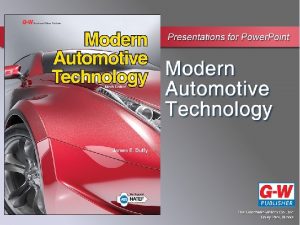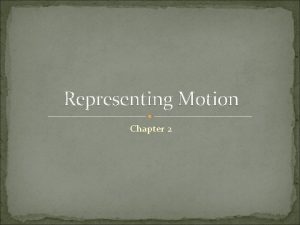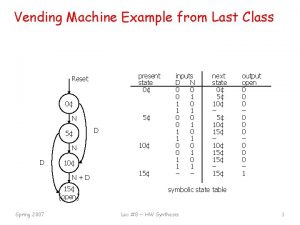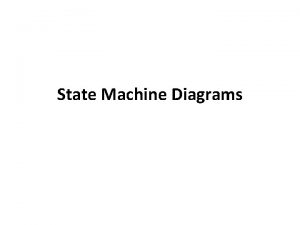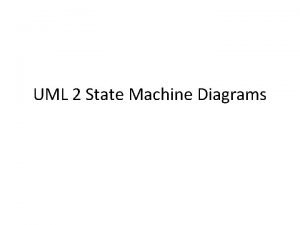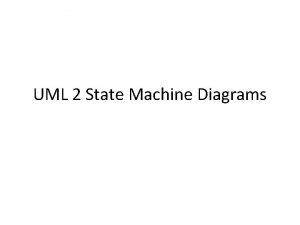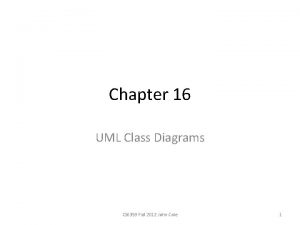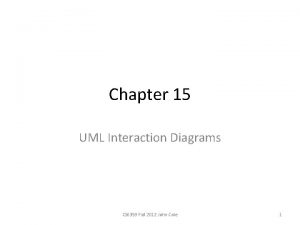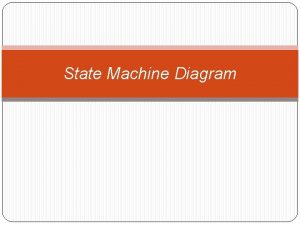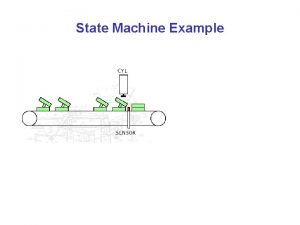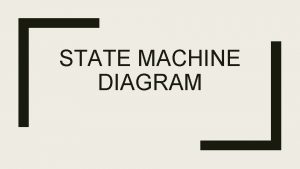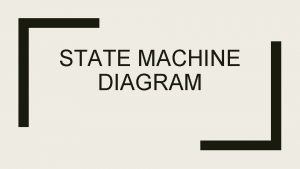Chapter 29 State Machine Diagrams CS 6359 Fall











- Slides: 11

Chapter 29 State Machine Diagrams CS 6359 Fall 2011 John Cole 1

State Machine Diagrams • They show a dynamic view, the interactions between states of an object and reaction to events. CS 6359 Fall 2012 John Cole 2

Event • A significant or noteworthy occurrence – A telephone is taken off-hook – A key is pressed on a keyboard – A door is opened – A quarter is put into a vending machine CS 6359 Fall 2011 John Cole 3

Transition • Relationship between two states that indicates that when an event occurs, the object moves from the prior state to the subsequent state. • When off-hook occurs, transition from Idle to Active state CS 6359 Fall 2011 John Cole 4

Applying the Diagrams • If an object always responds the same way to an event, it is state-independent or modeless. • State-dependent objects react differently to messages depending upon their state. • A telephone is very state-dependent. Its response to pushing buttons depends whether it is on-hook or off-hook and whethere is an ongoing call or not. CS 6359 Fall 2011 John Cole 5

When to Use • Consider state machines and diagrams for complex, state-dependent objects, not for state-independent objects. • Business information systems seldom have much state-dependent behavior (although the UI may have some) • Process control, device control, and telecom have many state-dependent objects CS 6359 Fall 2011 John Cole 6

Modeling State-Dependent Objects • State machines applied in 2 ways: – Model the behavior of a complex reactive object in response to events – Model legal sequences of operations such as protocol or language specifications. A formal grammar is a kind of state machine CS 6359 Fall 2011 John Cole 7

Complex Reactive Objects • Physical devices • Transactions between related business objects. How does sale, order or payment react to an event? • Role mutators are objects that change roles based upon events. Person changes from civilian to veteran. City changes from destination to origin. CS 6359 Fall 2011 John Cole 8

Protocols • TCP can be understood with a state machine diagram • UI page/window flow or navigation • UI flow controllers or sessions • Use case system operations • Individual UI event handling CS 6359 Fall 2011 John Cole 9

Transition Actions and Guards • Transition cause an action. This may be invocation of a method. Transition may also have a test and it occurs only if the test passes. CS 6359 Fall 2011 John Cole 10

Nested States • States can have substates which inherit the transitions of the superstate. CS 6359 Fall 2011 John Cole 11
 The interaction diagrams, use case diagrams are called as
The interaction diagrams, use case diagrams are called as Rake symbol in activity diagram
Rake symbol in activity diagram Finite state machine vending machine example
Finite state machine vending machine example State diagrams uml
State diagrams uml What is the date for the sc fbla state fall virtual rally?
What is the date for the sc fbla state fall virtual rally? Jsa stands for
Jsa stands for Chapter 21 wiring diagrams and wiring repairs
Chapter 21 wiring diagrams and wiring repairs Representing motion
Representing motion Mealy and moore model
Mealy and moore model Mealy to moore conversion
Mealy to moore conversion Energy work and simple machines chapter 10 answers
Energy work and simple machines chapter 10 answers Vending machine state diagram
Vending machine state diagram






